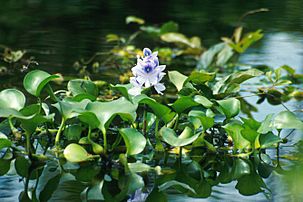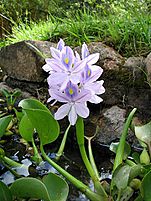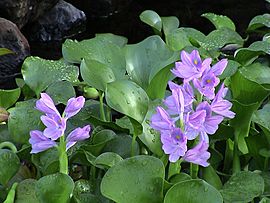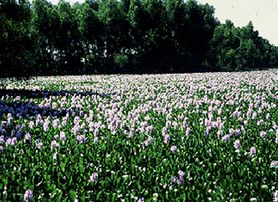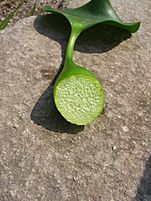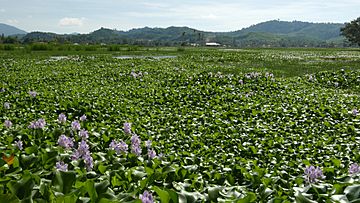Common water hyacinth facts for kids
Quick facts for kids Common water hyacinth |
|
|---|---|
 |
|
| Scientific classification | |
| Genus: |
Eichhornia
|
| Species: |
crassipes
|
| Synonyms | |
|
|
Pontederia crassipes, often called common water hyacinth, is a water plant that originally comes from the Amazon basin. It is known for being a big problem as an invasive species in many places outside its home. It's the only plant in the Pontederia subgenus Oshunae.
Contents
What is Water Hyacinth?
Water hyacinth is a plant that floats freely on water. It lives for many years and is native to warm, tropical parts of South America. This plant can grow quite tall, sometimes up to 1 meter (3 feet) above the water.
Its leaves are wide, thick, shiny, and oval-shaped. They can be 10–20 cm (4–8 inches) across. The plant floats because of special bulb-like parts at the base of its stems. Its roots are dark purple and hang freely in the water. A tall stem holds a single group of 8 to 15 pretty flowers, usually lavender or pink, with six petals. When it's not flowering, water hyacinth can look like other water plants such as frog's-bit.
How Fast Does It Grow?
Water hyacinth is one of the fastest-growing plants known! It mostly reproduces using "runners" or stolons, which are like little stems that grow new plants. Each plant can also make thousands of seeds every year. These seeds can stay alive for over 28 years.
Some water hyacinths have been seen to grow between 2 and 5 meters (7 and 16 feet) a day in parts of Southeast Asia. Large groups of water hyacinth can double in size in just one to two weeks. In terms of how many plants there are, they can multiply more than a hundred times in only 23 days!
In its native home, bees with long tongues help pollinate these flowers. The plant can reproduce both by seeds and by making copies of itself (cloning). This ability to clone itself is a big reason why it spreads so quickly and becomes invasive.
Water hyacinth flowers come in three different forms, based on the length of their central part (pistil): long, medium, and short. However, in places where the plant has been introduced, the medium form is most common. This shows that a few plants started the spread around the world.
Where Does It Live?
Water hyacinth can live in many different warm places, from tropical deserts to rainforests. It likes temperatures between 25–30 °C (77–86 °F) best, but can grow from 12 °C (54 °F) up to 35 °C (95 °F). It prefers water with a pH between 5.0 and 7.5.
Cold weather (frost) kills its leaves, and it doesn't like water hotter than 34 °C (93 °F). It also doesn't grow well in salty water. If the water is too salty, its leaves turn yellow and die.
What Else is in the Plant?
Fresh water hyacinth plants have tiny, prickly crystals. It's also reported to contain certain chemicals that can make your skin itch. If the plants are sprayed with certain chemicals, they can collect harmful elements from polluted water.
How is Water Hyacinth Used?
Because water hyacinths grow so much, harvesting them for different uses can also help control their spread.
Crafts and Materials
In places like north-east India, the Philippines, Thailand, and Vietnam, the stems of water hyacinth are dried and used for braiding. These fibers are woven into bags, shoes, hats, vases, and other decorative items. Dried stems are also used to make baskets and furniture. Water hyacinth fibers can even be used to make paper.
Energy and Cleaning Water
Since the plant has a lot of nitrogen, it can be used to produce biogas, which is a type of fuel.
Water hyacinth is very good at soaking up heavy metals like cadmium, chromium, lead, and mercury from water. This makes it useful for cleaning up dirty water from factories. It can also remove other harmful substances like cyanide, which is helpful in areas affected by gold mining.
Food and Fertilizer
Water hyacinth can be used as food for animals, especially in developing countries. It has a lot of protein and important minerals. However, it can also absorb toxins, so it might become contaminated if used as feed.
The plant is also used as organic matter for making compost in organic farming. In India and Bangladesh, farmers use it as fertilizer or as food for livestock and fish. In Bangladesh, farmers even build "floating gardens" using dried water hyacinth as a base to grow vegetables during the monsoon season when their land is flooded.
Other Uses
Around the world, people use water hyacinth to make furniture, handbags, baskets, and other household items. Some artists have even used it in their artwork.
In Taiwan, the plant is eaten as a vegetable, and in Java and Vietnam, people sometimes cook and eat its young leaves and flowers. In Malaysia, the flowers are used in traditional medicine for horses.
Why is Water Hyacinth a Problem?
Water hyacinth has been introduced to many parts of the world, including North America, Europe, Asia, Australia, and Africa. In these new places, it often doesn't have natural enemies, so it can multiply very quickly and cause big problems.
Environmental Impact
When water hyacinth grows out of control, it can completely cover lakes and ponds. This slows down water flow and blocks sunlight from reaching other plants that live underwater. These native plants often die. As the water hyacinth decays, it uses up the oxygen in the water, which can kill fish.
The dense mats of water hyacinth also create a perfect home for mosquitos, which can spread diseases. They also attract certain types of snails that carry a parasitic flatworm which causes a disease called schistosomiasis (or snail fever). In some areas, water hyacinth has been blamed for causing hunger among farmers because it blocks waterways and fishing.
Water hyacinth often invades water bodies that are already affected by human activities, like artificial lakes or lakes with too many nutrients from pollution.
Economic and Social Impact
When water hyacinth covers a waterway, it can stop boats and ships from moving, which hurts transportation and fishing. Communities can lose their access to water and food.
A lot of money is spent trying to remove water hyacinth. Removing it mechanically is very hard because the plants are so heavy. Also, the harvested plants can be toxic because they absorb pollutants, which makes disposal a challenge. This method is also not very effective for large areas because the plant grows much faster than it can be removed.
How is Water Hyacinth Controlled?
Controlling water hyacinth depends on how bad the problem is, the local climate, and how close it is to people and wildlife. There are three main ways to control it:
Chemical Control
This method uses special chemicals called herbicides to kill the plants. It's the least common method because it can harm the environment and human health in the long run. Herbicides are usually only used for small areas where the water hyacinth is a severe problem.
While it can be cheaper and easier than mechanical removal, the chemicals can get into the groundwater and affect water systems and people. Also, herbicides can kill other important plants and organisms, disrupting the natural balance of the ecosystem.
Common herbicides like 2,4-D, glyphosate, and diquat are sprayed on the leaves. They change how the plant grows and eventually kill it. It can take a few weeks for the plants to die completely.
Physical Control
This involves using machines on land or in the water to remove the plants. These machines can be cranes, dredges, or special aquatic weed harvesters. Mechanical removal is a good short-term solution. For example, on Lake Victoria in Africa, machines removed a huge amount of water hyacinth in one year.
However, this method is expensive, costing millions of dollars each year. It's also a continuous process because the plants grow back quickly. A big problem with mechanical harvesting is that if the plants are broken into small pieces, these pieces can easily grow into new infestations. Also, transporting and disposing of the heavy, toxic plants is difficult.
Biological Control
Since chemical and mechanical methods are often too expensive or not effective enough, scientists have looked into using "biological control agents." These are living organisms that help control the water hyacinth.
In the 1970s, researchers in the United States released two types of weevils (small beetles) and a moth that feed on water hyacinth. These insects were introduced in places like Louisiana, Texas, and Florida, where water hyacinth was a big problem. A decade later, the amount of water hyacinth had decreased by about 33%. These insects help by limiting the plant's size, how it spreads, and how many seeds it produces. They also carry tiny organisms that can harm the water hyacinth. When the weevils eat the plant's stems, the plant loses its ability to float and sinks.
In 2010, another insect called Megamelus scutellaris, a small planthopper from Argentina, was released. Scientists studied it carefully to make sure it would only harm water hyacinth and no other plants. They hope this insect will be even more effective.
Another insect being studied is a grasshopper called Cornops aquaticum. This grasshopper also eats water hyacinth and can introduce diseases to the plant.
Interestingly, introducing manatees (large, gentle sea mammals) into waterways in Guyana has also helped control the plant's growth, as manatees eat water hyacinth.
Gallery
See also
 In Spanish: Jacinto de agua para niños
In Spanish: Jacinto de agua para niños


